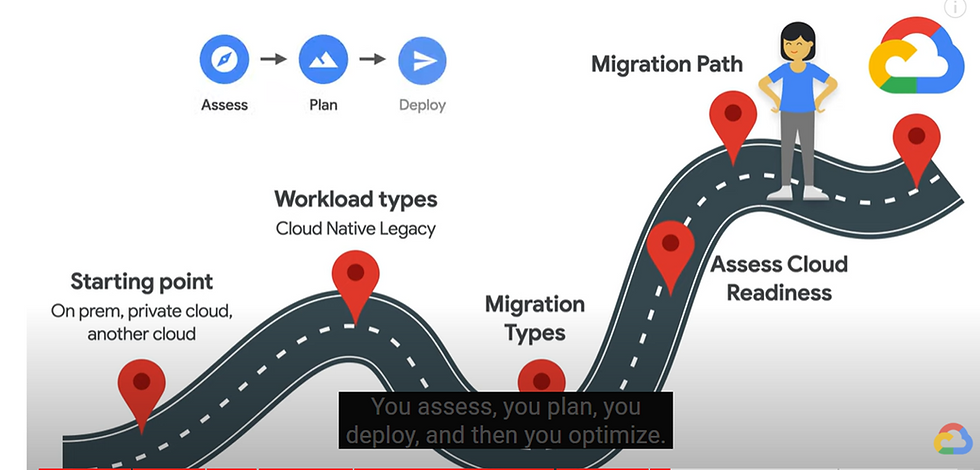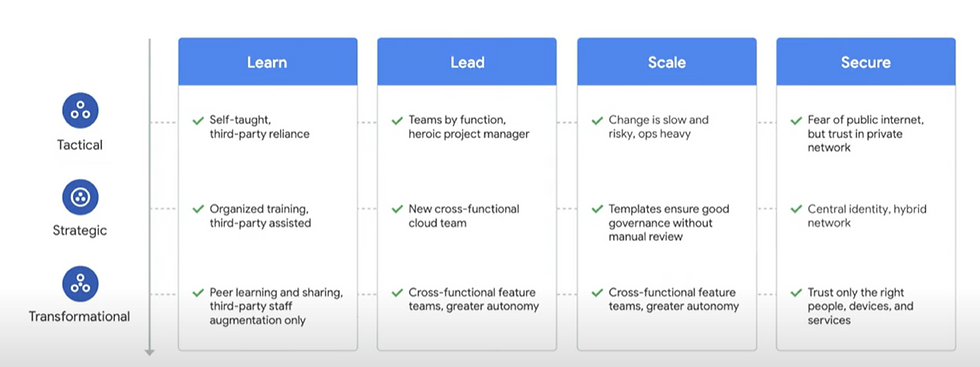Google Cloud Migration Journey
- Anand Nerurkar
- Jul 18, 2023
- 2 min read
Updated: Sep 28, 2023

. Work closely with Customer,Business stakeholer to understand the business objective and buisness outcome.
Business Goals
Business Objectives
Technocal Goals
.Understand the context and environment
Decommision some workload
Consolidate Application Portfolio
VM move to Cloud
Modernize the workload
.Build a Catalog of
Applications
Workloads
Dependency
Application Stack
Infrastructure requirements
-VM
-Container
-Database
-Server
-Messaging server
Networking requirements
Firewall Rules
Security Requirements
Once it is categorized and build out this list, we can start building migration strategy moving forward.
. Identify any contraint that can not be moved ot cloud
---licensing cost
---3rd party framework/library
---tech stack not virtulizable
For ex: Mainframe can not be moved to Cloud
In such scenario, it may not be technically feasible to move to cloud, we can keep it as it is in the current env.
· Identify starting point in cloud journey
o Current state
On premise
Private cloud
Any other cloud
Hybrid cloud
o Target state
· Workload Type
o Legacy workload
– expensive to migrate.
- Here we can apply Rip & Replace migration type
o Cloud Native workload
· Migration Type
o Lift & Shift
Migrate as it is from current env to cloud
Little or no modification
Taking least advantage of cloud
Easier to migrate
o Improve & Move
Refactoring
Modernize the workload
Take advantage of cloud offering
o Rip & Replace
Greenfield- Develop app from scratch
Maximum benefit of cloud offering
Take long time to migrate since it is greenfield
· Asses Cloud Readiness
o It depends on following themes
Learn- Learning Programme
Lead - Leadership Support
Scale – Capacity to scale
Secure – capacity to secure the workload
o It depends on following Phases across those themes
Tactical Phase
Strategic
Transformational

· Migration Path
o Assess
Understand the current environment
Workload assessment
Identify inventory
Identify dependency and any other requirement
Risk identification and mitigation plan
Perform TCO calculation
Budget/funding
Establish app performance benchmark- KPI that need to be tracked
o Plan
Basic Infrastructure Cloud plan
Detail plan – how will you move to target state
Develop prioritized migration strategy
For example: Planning may include
1. Creating Organization
Setting up the organization account
Setting up users or migrating users from Active Directory to GCP
Setting up IAM policy as per the RBAC
Access control to environment/project/resources as per IAM requirements
2. Setting up Network Design –
Check with client for the network requirements
CIDR ranges to be used
Create VPC, subnets, firewall rules,
Network connectivity like VPN ,Dedicated/Partner Interconnect
VPC Peering,Shared VPC
3. Creating folders
Creating environments
Development
QA
Staging
Production
4. Creating project
5. Creating Resources for each project
Depending on the project requirements or based on the requirement , approved private service catalog containing project resources to be used
Terraform scripting for Infrastructure as a code
o Deploy
Design->Implement->Execute deployment processes to move workload to GCP
o Optimize
Use benefits of cloud native capabilities for GCP
Monitor application performance with GCP operation suite
Based on capacity planning, identify parameters and thresholds where you can configure autoscaling policy to scale out /scale in based on load, perform health check regularly
Configure notification/alert policy
Disaster Recovery
Costing
Training
Application Integration with AI capability for the app behaviour or prediction and fine tune it.
· End - We are now in Google Cloud.
.png)

Comments